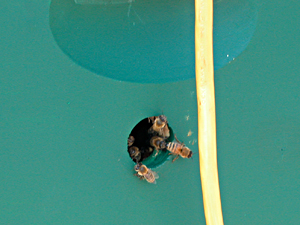 If October is the beekeeper's New Year, when everything gets carefully tucked away for the winter respite, June is the month of ultimate hustle and expansion. This picture of the bees busily making their way in and out of the new ventilation holes I am adding to the hive bodies (as time allows!) is pretty much how this month has gone for me, too.
If October is the beekeeper's New Year, when everything gets carefully tucked away for the winter respite, June is the month of ultimate hustle and expansion. This picture of the bees busily making their way in and out of the new ventilation holes I am adding to the hive bodies (as time allows!) is pretty much how this month has gone for me, too.June in this area usually brings the last, big burst of the nectar flow, a yearly orgy of pollen and flower juice. Around here, the big contributors are trees: tulip poplar and black locust are the ones all the beekeepers talk about, but the wide avenues of my fair city are also lined with lindens. The latter are called "basswood" by the old timers, and provide lots of honey that most around here find a bit on the tart side. On the street level, the lavender, Russian sage, and white clover come into their own, providing a follow-on harvest that is supposed to take us into July.
This year, the nectar flow was weird. We had a drought just at bloom time, and that seems to have held down the amount of nectar collected, caused the bees to clog the combs with more pollen than they could use in three years, and (perhaps) triggered a number of supercedures. It looks like the bees blame their queens for their hard times, much like people blame anyone they can, and seek solutions through regicide. Thus I learned that Queen Elizabeth is no more in the Wilde colony. I have not yet gotten around to marking and naming her successor. There's some trouble in this: it really seems like the colony is less active now, and we may have another case of a local girl who could not mate adequately in this low stock of drones.
This month was therefore spent, on the bee front, starting an early program of feeding bees in five hives and three locations. I had a leaky feeder that needed repair, and started taking advantage of a method MaryEllen uses which deploys poultry waterers with sugar syrup inside: no drowned bees at all!
I also spent two separate weeks in New England, helping my cousin disassemble one life and lay the groundwork for a new one. Newfound talent: I'm really good at tossing out stuff, if it belongs to someone else. If you will help me wrangle my bees, I will help you clean your basement. Be warned: I may send you out for beer and chips if you get too sentimental on me! Just close your eyes and think of England, OK?
Appropriately enough, a week of sad necessity was followed by a week of record rain, more than righting the drought deficit of the previous two months. But will it bring more flowers, you know?
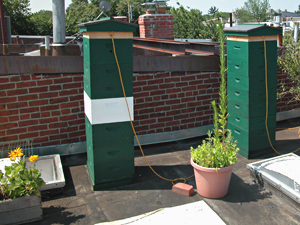 If you will take my basement offer, I would be grateful. You see, I really do need some help in rationalizing my roof bees. Do you see these towers here? This is not some banner honey year, with two boxes of bees below and a pile of honey supers above. Oh no. This is the result of mixed woodenware (deeps with honey frames, mediums with brood, ugh!), the addition of a nuc's worth of bees to Twain in mid-June, and the proliferation of pollen-clogged frames in various sizes without always having enough foundation to replace them. At one point this month, I tried to use a hose to blow the pollen clogs out of the drawn comb (in order to re-use the latter — hey, some beekeepers say it works) and NOTHING happened. I have brood spread across four boxes in these hives, honey left here-there-and-everywhere as the bees found space, and pollen generally getting in the way whenever possible.
If you will take my basement offer, I would be grateful. You see, I really do need some help in rationalizing my roof bees. Do you see these towers here? This is not some banner honey year, with two boxes of bees below and a pile of honey supers above. Oh no. This is the result of mixed woodenware (deeps with honey frames, mediums with brood, ugh!), the addition of a nuc's worth of bees to Twain in mid-June, and the proliferation of pollen-clogged frames in various sizes without always having enough foundation to replace them. At one point this month, I tried to use a hose to blow the pollen clogs out of the drawn comb (in order to re-use the latter — hey, some beekeepers say it works) and NOTHING happened. I have brood spread across four boxes in these hives, honey left here-there-and-everywhere as the bees found space, and pollen generally getting in the way whenever possible. MaryEllen says she will come over to help me take the hives apart and somehow reduce these colonies to proper size. She says her husband is in the same boat.
There is lots and lots to show you from the month of June, but this post is too long already. Therefore, I'll be cheating a bit and in-filling previous dates with information about all the many goings-on, including the monastery and historical park bees. Every day this month I got up and thought about bees, and then blogs, and as each passed the work to get it all to you seemed more and more monumental. I apologize for those few who have been slogging away with me this long, and hope to make it all worthwhile some how.
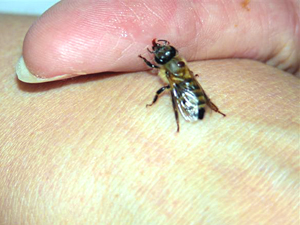 Today we had our first summer camp presentation, but (in this sad world of ours) pictures of the kids are not allowed. So here is a picture of a bee with a mite that we found today, which means that the time to treat for varroa is already here. This is another item on a growing list. The bee is taking honey from my finger, a picture taken by MaryEllen. I suppose with the clarity of those fingerprints, you could run me through Interpol now.
Today we had our first summer camp presentation, but (in this sad world of ours) pictures of the kids are not allowed. So here is a picture of a bee with a mite that we found today, which means that the time to treat for varroa is already here. This is another item on a growing list. The bee is taking honey from my finger, a picture taken by MaryEllen. I suppose with the clarity of those fingerprints, you could run me through Interpol now.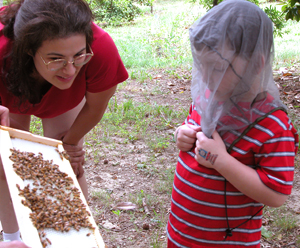
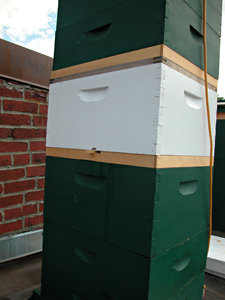 Apparently, book learning is not what it is cracked up to be (yet again), because Larry got really worried when I told him what I intended to do with the bees he entrusted to my care yesterday. I was going to place them at the bottom of Twain, with some newspaper for the girls to chew through to delay contact and get them used to each other before the fact. Larry said it was not a great idea to put new bees below old. He even called me at home to reiterate this point! Therefore, I set the hive up the way you see it at left.
Apparently, book learning is not what it is cracked up to be (yet again), because Larry got really worried when I told him what I intended to do with the bees he entrusted to my care yesterday. I was going to place them at the bottom of Twain, with some newspaper for the girls to chew through to delay contact and get them used to each other before the fact. Larry said it was not a great idea to put new bees below old. He even called me at home to reiterate this point! Therefore, I set the hive up the way you see it at left.